Methods in Cognition & Neuroscience: Article Critique Report
VerifiedAdded on 2022/08/24
|6
|1334
|37
Report
AI Summary
This report provides a critical analysis of the research article by Zokaei et al. (2014), focusing on the methodological aspects of their study on working memory. The study employed transcranial magnetic stimulation (TMS) to investigate the differential susceptibility of items in working memory, with experiments manipulating item relevance and serial position. The report evaluates the appropriateness of the methods, including fMRI for MT+ localization and the use of two-way ANOVA for data analysis. It discusses ethical considerations, particularly regarding informed consent and participant awareness. The analysis highlights limitations such as unequal sample sizes and potential biases. The report concludes that while the findings have potential implications, the study's validity and reliability are compromised by methodological shortcomings and ethical concerns, necessitating improvements in sampling and ethical practices for future research. The report also discusses how the study's findings suggest that TMS over the visual cortex can weaken the representation of privileged items in working memory, increasing the recall precision of non-privileged items, but further research is needed to address the limitations of the current study.
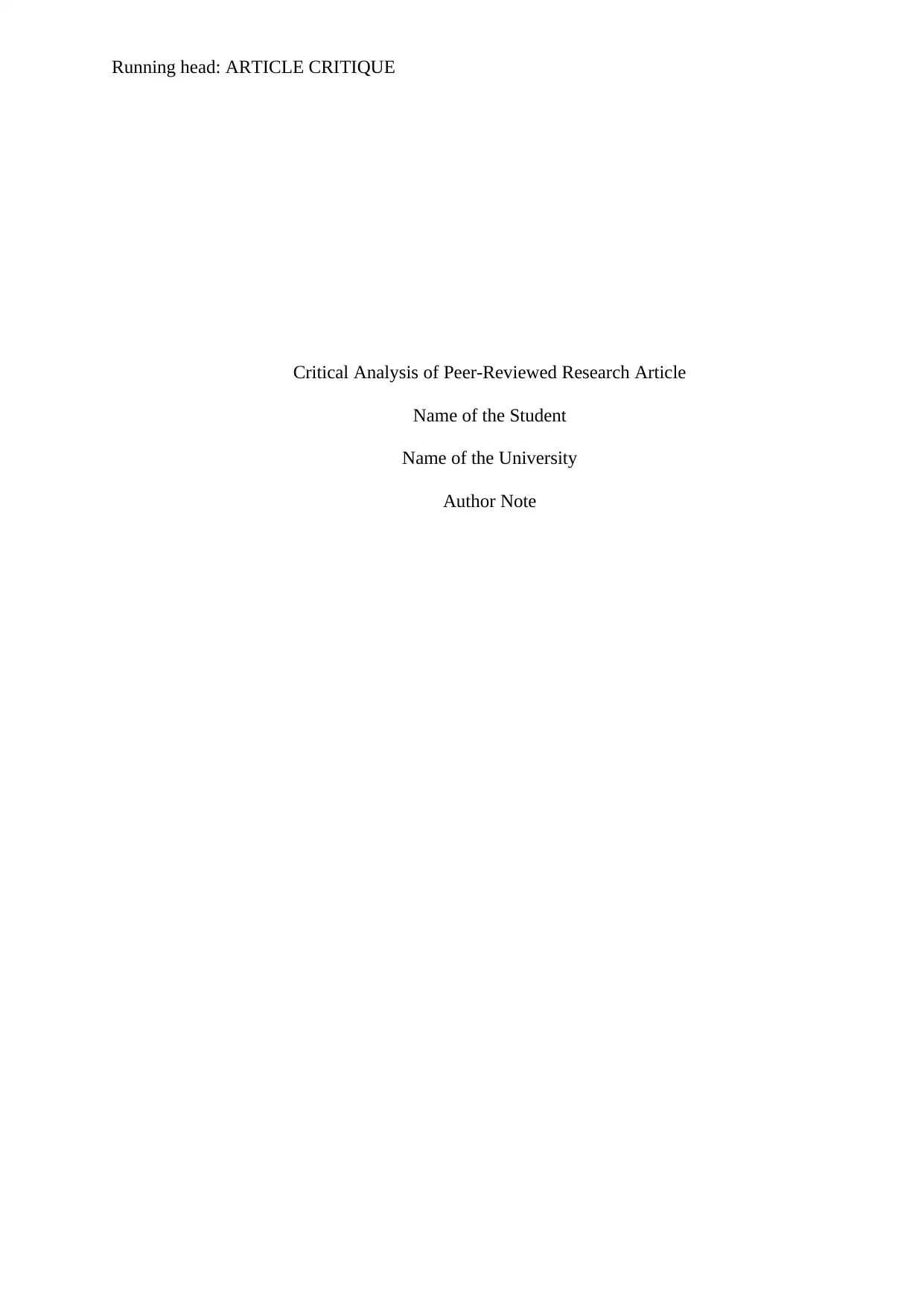
Running head: ARTICLE CRITIQUE
Critical Analysis of Peer-Reviewed Research Article
Name of the Student
Name of the University
Author Note
Critical Analysis of Peer-Reviewed Research Article
Name of the Student
Name of the University
Author Note
Secure Best Marks with AI Grader
Need help grading? Try our AI Grader for instant feedback on your assignments.
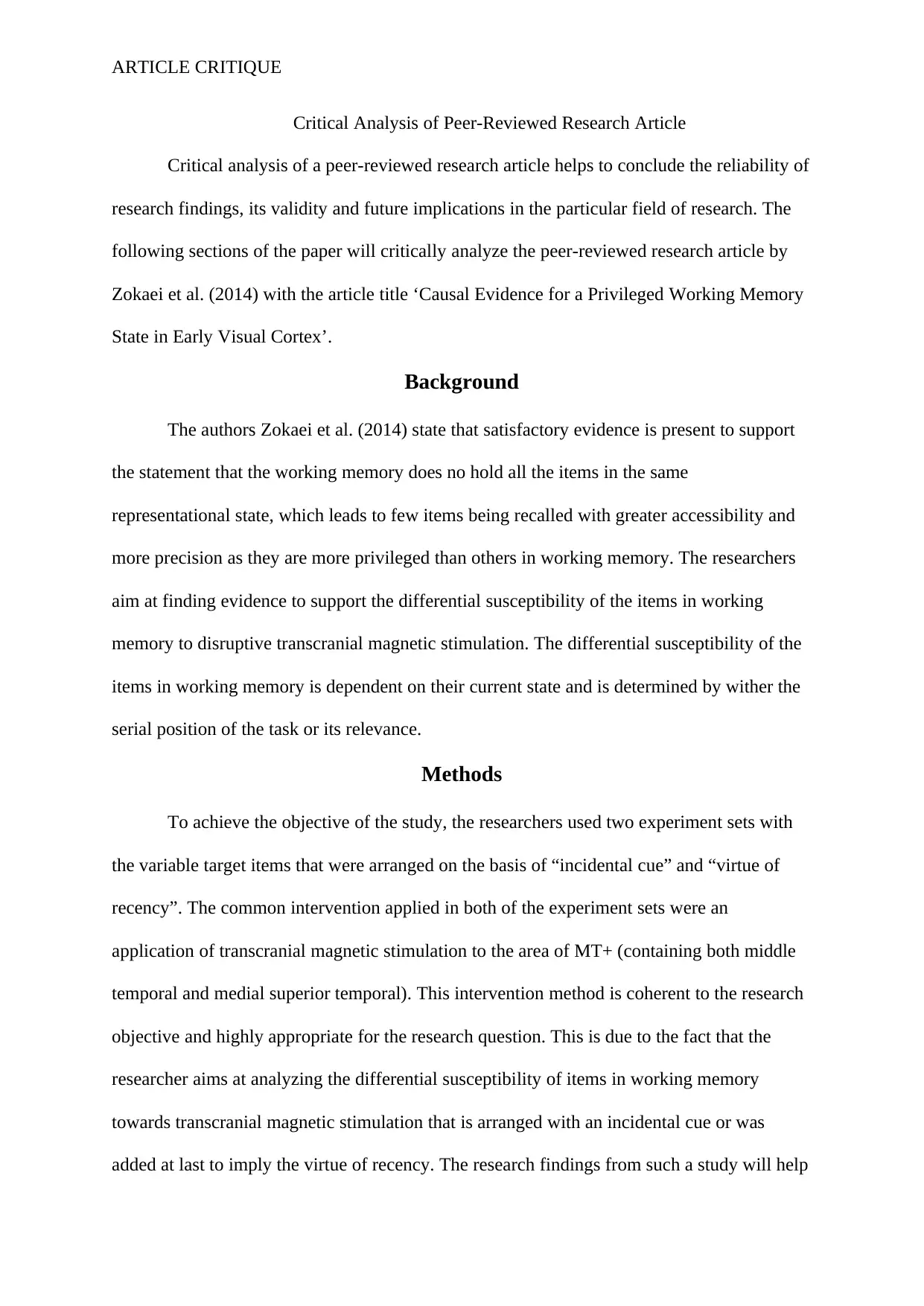
ARTICLE CRITIQUE
Critical Analysis of Peer-Reviewed Research Article
Critical analysis of a peer-reviewed research article helps to conclude the reliability of
research findings, its validity and future implications in the particular field of research. The
following sections of the paper will critically analyze the peer-reviewed research article by
Zokaei et al. (2014) with the article title ‘Causal Evidence for a Privileged Working Memory
State in Early Visual Cortex’.
Background
The authors Zokaei et al. (2014) state that satisfactory evidence is present to support
the statement that the working memory does no hold all the items in the same
representational state, which leads to few items being recalled with greater accessibility and
more precision as they are more privileged than others in working memory. The researchers
aim at finding evidence to support the differential susceptibility of the items in working
memory to disruptive transcranial magnetic stimulation. The differential susceptibility of the
items in working memory is dependent on their current state and is determined by wither the
serial position of the task or its relevance.
Methods
To achieve the objective of the study, the researchers used two experiment sets with
the variable target items that were arranged on the basis of “incidental cue” and “virtue of
recency”. The common intervention applied in both of the experiment sets were an
application of transcranial magnetic stimulation to the area of MT+ (containing both middle
temporal and medial superior temporal). This intervention method is coherent to the research
objective and highly appropriate for the research question. This is due to the fact that the
researcher aims at analyzing the differential susceptibility of items in working memory
towards transcranial magnetic stimulation that is arranged with an incidental cue or was
added at last to imply the virtue of recency. The research findings from such a study will help
Critical Analysis of Peer-Reviewed Research Article
Critical analysis of a peer-reviewed research article helps to conclude the reliability of
research findings, its validity and future implications in the particular field of research. The
following sections of the paper will critically analyze the peer-reviewed research article by
Zokaei et al. (2014) with the article title ‘Causal Evidence for a Privileged Working Memory
State in Early Visual Cortex’.
Background
The authors Zokaei et al. (2014) state that satisfactory evidence is present to support
the statement that the working memory does no hold all the items in the same
representational state, which leads to few items being recalled with greater accessibility and
more precision as they are more privileged than others in working memory. The researchers
aim at finding evidence to support the differential susceptibility of the items in working
memory to disruptive transcranial magnetic stimulation. The differential susceptibility of the
items in working memory is dependent on their current state and is determined by wither the
serial position of the task or its relevance.
Methods
To achieve the objective of the study, the researchers used two experiment sets with
the variable target items that were arranged on the basis of “incidental cue” and “virtue of
recency”. The common intervention applied in both of the experiment sets were an
application of transcranial magnetic stimulation to the area of MT+ (containing both middle
temporal and medial superior temporal). This intervention method is coherent to the research
objective and highly appropriate for the research question. This is due to the fact that the
researcher aims at analyzing the differential susceptibility of items in working memory
towards transcranial magnetic stimulation that is arranged with an incidental cue or was
added at last to imply the virtue of recency. The research findings from such a study will help
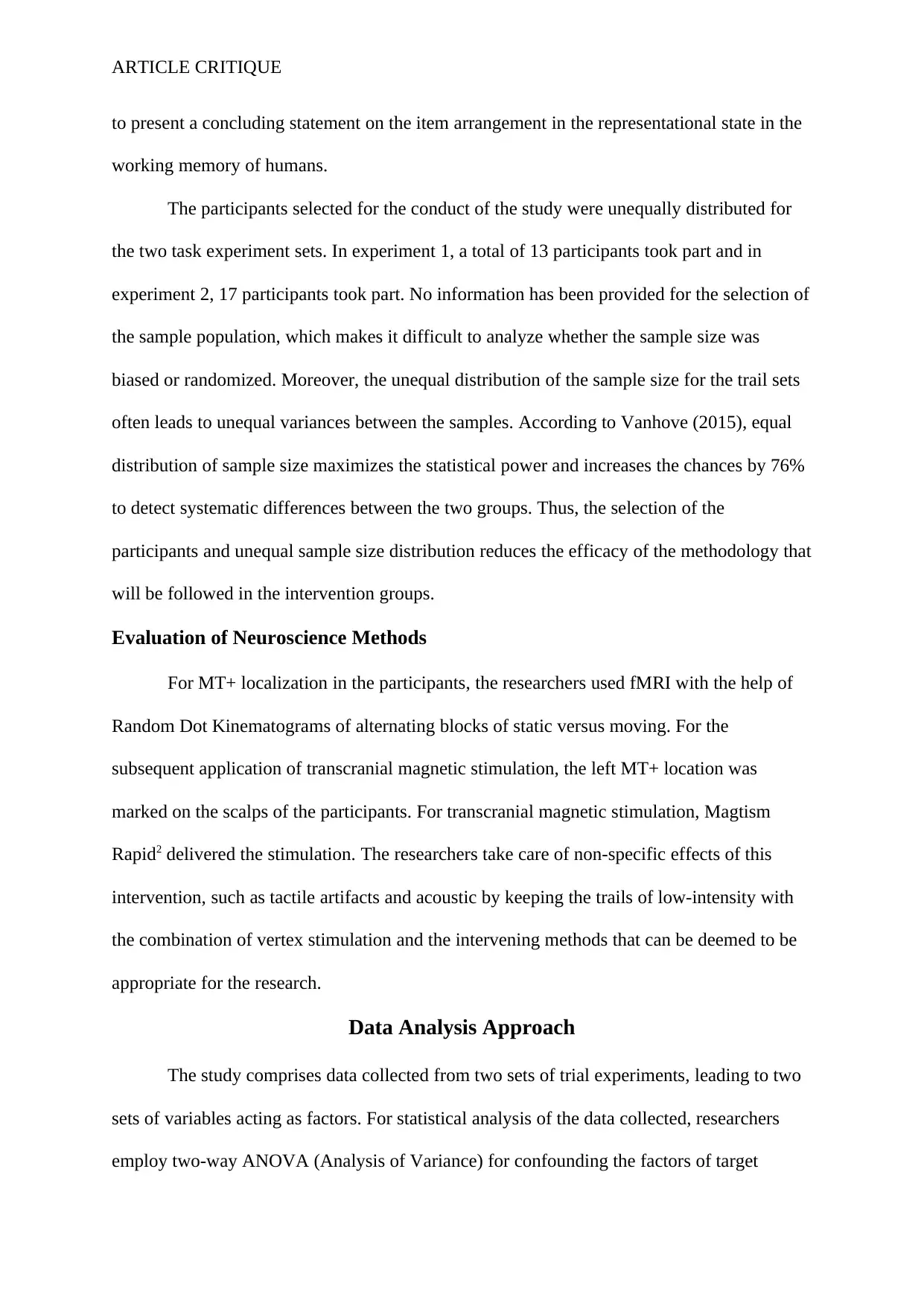
ARTICLE CRITIQUE
to present a concluding statement on the item arrangement in the representational state in the
working memory of humans.
The participants selected for the conduct of the study were unequally distributed for
the two task experiment sets. In experiment 1, a total of 13 participants took part and in
experiment 2, 17 participants took part. No information has been provided for the selection of
the sample population, which makes it difficult to analyze whether the sample size was
biased or randomized. Moreover, the unequal distribution of the sample size for the trail sets
often leads to unequal variances between the samples. According to Vanhove (2015), equal
distribution of sample size maximizes the statistical power and increases the chances by 76%
to detect systematic differences between the two groups. Thus, the selection of the
participants and unequal sample size distribution reduces the efficacy of the methodology that
will be followed in the intervention groups.
Evaluation of Neuroscience Methods
For MT+ localization in the participants, the researchers used fMRI with the help of
Random Dot Kinematograms of alternating blocks of static versus moving. For the
subsequent application of transcranial magnetic stimulation, the left MT+ location was
marked on the scalps of the participants. For transcranial magnetic stimulation, Magtism
Rapid2 delivered the stimulation. The researchers take care of non-specific effects of this
intervention, such as tactile artifacts and acoustic by keeping the trails of low-intensity with
the combination of vertex stimulation and the intervening methods that can be deemed to be
appropriate for the research.
Data Analysis Approach
The study comprises data collected from two sets of trial experiments, leading to two
sets of variables acting as factors. For statistical analysis of the data collected, researchers
employ two-way ANOVA (Analysis of Variance) for confounding the factors of target
to present a concluding statement on the item arrangement in the representational state in the
working memory of humans.
The participants selected for the conduct of the study were unequally distributed for
the two task experiment sets. In experiment 1, a total of 13 participants took part and in
experiment 2, 17 participants took part. No information has been provided for the selection of
the sample population, which makes it difficult to analyze whether the sample size was
biased or randomized. Moreover, the unequal distribution of the sample size for the trail sets
often leads to unequal variances between the samples. According to Vanhove (2015), equal
distribution of sample size maximizes the statistical power and increases the chances by 76%
to detect systematic differences between the two groups. Thus, the selection of the
participants and unequal sample size distribution reduces the efficacy of the methodology that
will be followed in the intervention groups.
Evaluation of Neuroscience Methods
For MT+ localization in the participants, the researchers used fMRI with the help of
Random Dot Kinematograms of alternating blocks of static versus moving. For the
subsequent application of transcranial magnetic stimulation, the left MT+ location was
marked on the scalps of the participants. For transcranial magnetic stimulation, Magtism
Rapid2 delivered the stimulation. The researchers take care of non-specific effects of this
intervention, such as tactile artifacts and acoustic by keeping the trails of low-intensity with
the combination of vertex stimulation and the intervening methods that can be deemed to be
appropriate for the research.
Data Analysis Approach
The study comprises data collected from two sets of trial experiments, leading to two
sets of variables acting as factors. For statistical analysis of the data collected, researchers
employ two-way ANOVA (Analysis of Variance) for confounding the factors of target
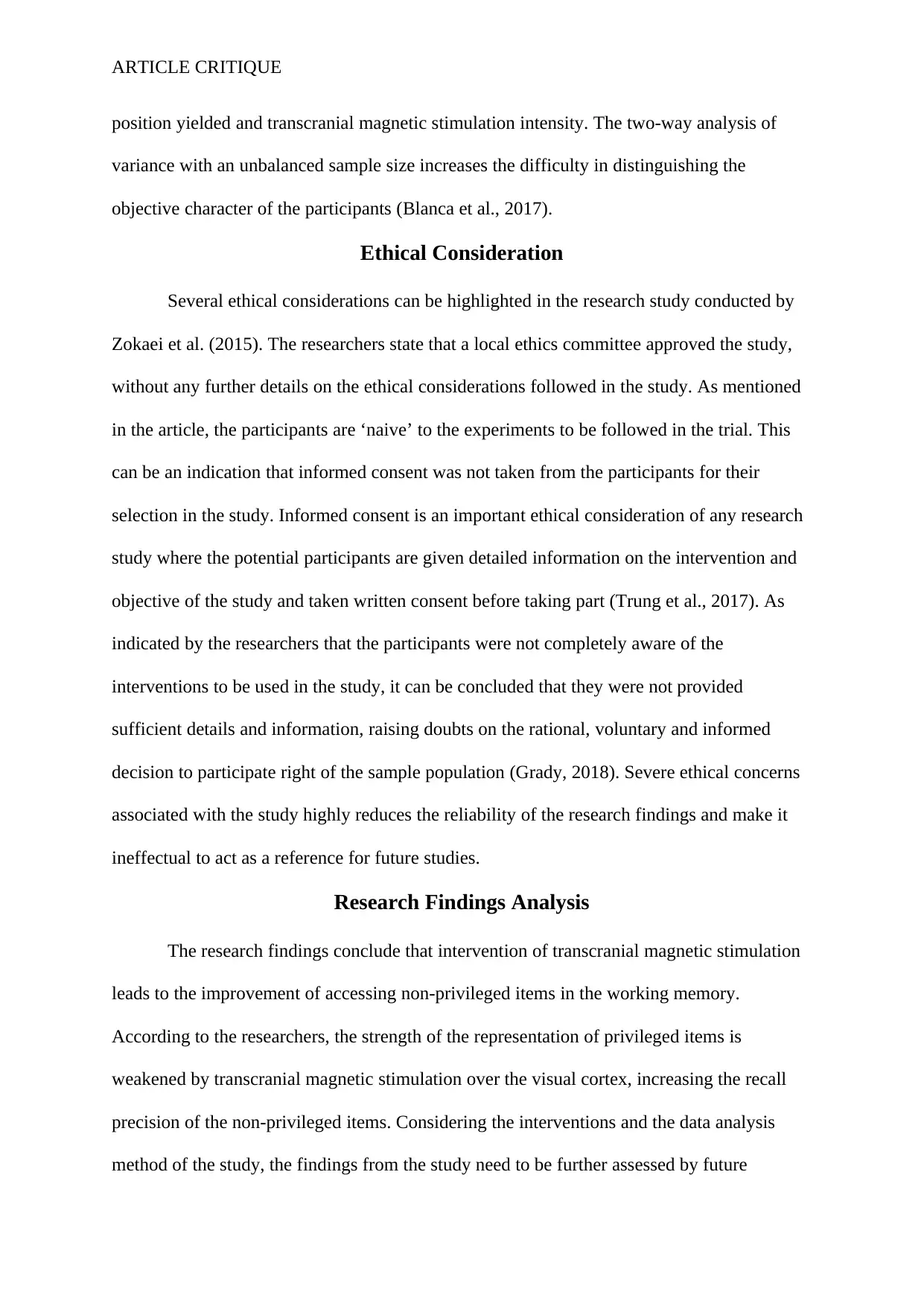
ARTICLE CRITIQUE
position yielded and transcranial magnetic stimulation intensity. The two-way analysis of
variance with an unbalanced sample size increases the difficulty in distinguishing the
objective character of the participants (Blanca et al., 2017).
Ethical Consideration
Several ethical considerations can be highlighted in the research study conducted by
Zokaei et al. (2015). The researchers state that a local ethics committee approved the study,
without any further details on the ethical considerations followed in the study. As mentioned
in the article, the participants are ‘naive’ to the experiments to be followed in the trial. This
can be an indication that informed consent was not taken from the participants for their
selection in the study. Informed consent is an important ethical consideration of any research
study where the potential participants are given detailed information on the intervention and
objective of the study and taken written consent before taking part (Trung et al., 2017). As
indicated by the researchers that the participants were not completely aware of the
interventions to be used in the study, it can be concluded that they were not provided
sufficient details and information, raising doubts on the rational, voluntary and informed
decision to participate right of the sample population (Grady, 2018). Severe ethical concerns
associated with the study highly reduces the reliability of the research findings and make it
ineffectual to act as a reference for future studies.
Research Findings Analysis
The research findings conclude that intervention of transcranial magnetic stimulation
leads to the improvement of accessing non-privileged items in the working memory.
According to the researchers, the strength of the representation of privileged items is
weakened by transcranial magnetic stimulation over the visual cortex, increasing the recall
precision of the non-privileged items. Considering the interventions and the data analysis
method of the study, the findings from the study need to be further assessed by future
position yielded and transcranial magnetic stimulation intensity. The two-way analysis of
variance with an unbalanced sample size increases the difficulty in distinguishing the
objective character of the participants (Blanca et al., 2017).
Ethical Consideration
Several ethical considerations can be highlighted in the research study conducted by
Zokaei et al. (2015). The researchers state that a local ethics committee approved the study,
without any further details on the ethical considerations followed in the study. As mentioned
in the article, the participants are ‘naive’ to the experiments to be followed in the trial. This
can be an indication that informed consent was not taken from the participants for their
selection in the study. Informed consent is an important ethical consideration of any research
study where the potential participants are given detailed information on the intervention and
objective of the study and taken written consent before taking part (Trung et al., 2017). As
indicated by the researchers that the participants were not completely aware of the
interventions to be used in the study, it can be concluded that they were not provided
sufficient details and information, raising doubts on the rational, voluntary and informed
decision to participate right of the sample population (Grady, 2018). Severe ethical concerns
associated with the study highly reduces the reliability of the research findings and make it
ineffectual to act as a reference for future studies.
Research Findings Analysis
The research findings conclude that intervention of transcranial magnetic stimulation
leads to the improvement of accessing non-privileged items in the working memory.
According to the researchers, the strength of the representation of privileged items is
weakened by transcranial magnetic stimulation over the visual cortex, increasing the recall
precision of the non-privileged items. Considering the interventions and the data analysis
method of the study, the findings from the study need to be further assessed by future
Secure Best Marks with AI Grader
Need help grading? Try our AI Grader for instant feedback on your assignments.
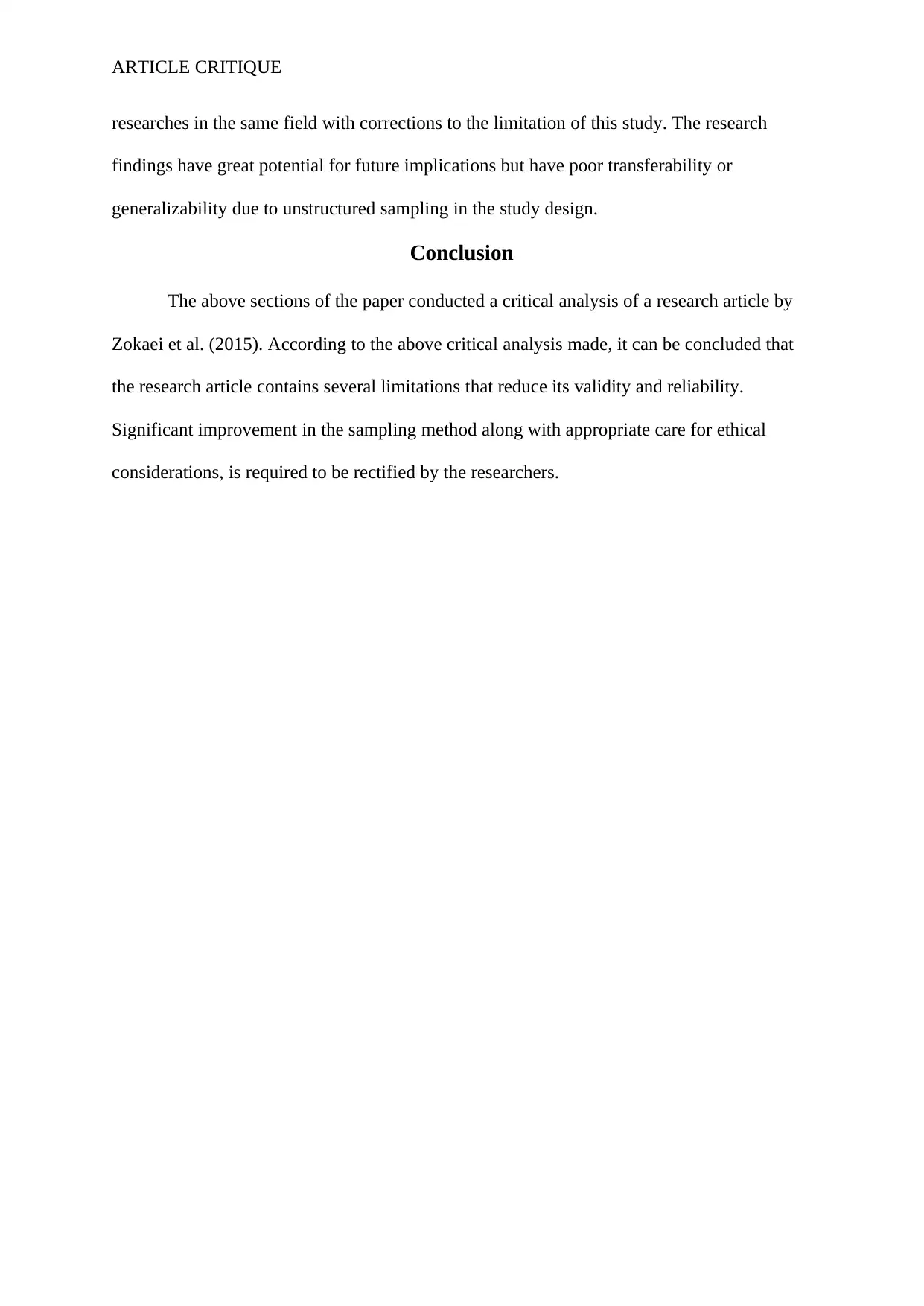
ARTICLE CRITIQUE
researches in the same field with corrections to the limitation of this study. The research
findings have great potential for future implications but have poor transferability or
generalizability due to unstructured sampling in the study design.
Conclusion
The above sections of the paper conducted a critical analysis of a research article by
Zokaei et al. (2015). According to the above critical analysis made, it can be concluded that
the research article contains several limitations that reduce its validity and reliability.
Significant improvement in the sampling method along with appropriate care for ethical
considerations, is required to be rectified by the researchers.
researches in the same field with corrections to the limitation of this study. The research
findings have great potential for future implications but have poor transferability or
generalizability due to unstructured sampling in the study design.
Conclusion
The above sections of the paper conducted a critical analysis of a research article by
Zokaei et al. (2015). According to the above critical analysis made, it can be concluded that
the research article contains several limitations that reduce its validity and reliability.
Significant improvement in the sampling method along with appropriate care for ethical
considerations, is required to be rectified by the researchers.
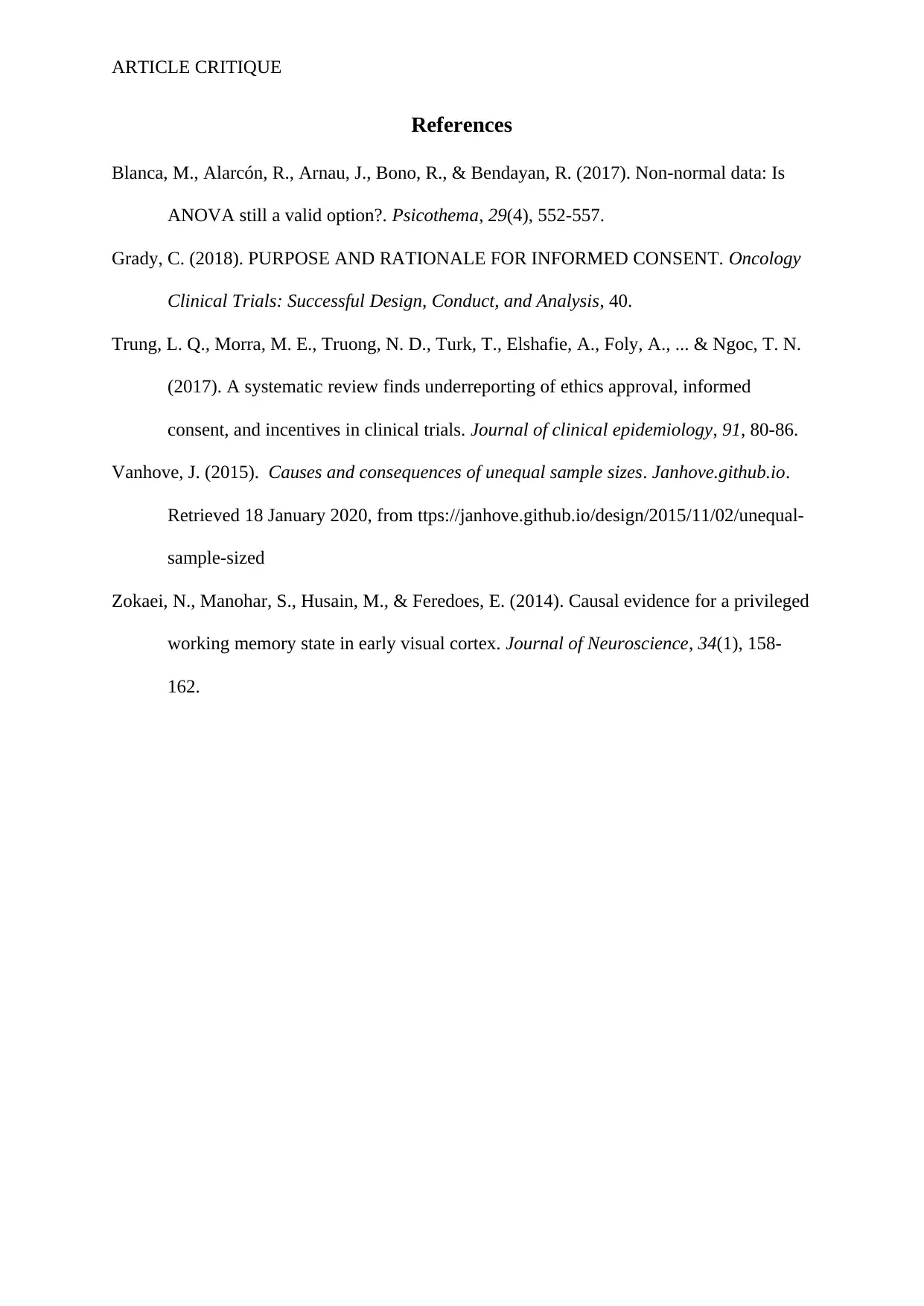
ARTICLE CRITIQUE
References
Blanca, M., Alarcón, R., Arnau, J., Bono, R., & Bendayan, R. (2017). Non-normal data: Is
ANOVA still a valid option?. Psicothema, 29(4), 552-557.
Grady, C. (2018). PURPOSE AND RATIONALE FOR INFORMED CONSENT. Oncology
Clinical Trials: Successful Design, Conduct, and Analysis, 40.
Trung, L. Q., Morra, M. E., Truong, N. D., Turk, T., Elshafie, A., Foly, A., ... & Ngoc, T. N.
(2017). A systematic review finds underreporting of ethics approval, informed
consent, and incentives in clinical trials. Journal of clinical epidemiology, 91, 80-86.
Vanhove, J. (2015). Causes and consequences of unequal sample sizes. Janhove.github.io.
Retrieved 18 January 2020, from ttps://janhove.github.io/design/2015/11/02/unequal-
sample-sized
Zokaei, N., Manohar, S., Husain, M., & Feredoes, E. (2014). Causal evidence for a privileged
working memory state in early visual cortex. Journal of Neuroscience, 34(1), 158-
162.
References
Blanca, M., Alarcón, R., Arnau, J., Bono, R., & Bendayan, R. (2017). Non-normal data: Is
ANOVA still a valid option?. Psicothema, 29(4), 552-557.
Grady, C. (2018). PURPOSE AND RATIONALE FOR INFORMED CONSENT. Oncology
Clinical Trials: Successful Design, Conduct, and Analysis, 40.
Trung, L. Q., Morra, M. E., Truong, N. D., Turk, T., Elshafie, A., Foly, A., ... & Ngoc, T. N.
(2017). A systematic review finds underreporting of ethics approval, informed
consent, and incentives in clinical trials. Journal of clinical epidemiology, 91, 80-86.
Vanhove, J. (2015). Causes and consequences of unequal sample sizes. Janhove.github.io.
Retrieved 18 January 2020, from ttps://janhove.github.io/design/2015/11/02/unequal-
sample-sized
Zokaei, N., Manohar, S., Husain, M., & Feredoes, E. (2014). Causal evidence for a privileged
working memory state in early visual cortex. Journal of Neuroscience, 34(1), 158-
162.
1 out of 6
Your All-in-One AI-Powered Toolkit for Academic Success.
+13062052269
info@desklib.com
Available 24*7 on WhatsApp / Email
![[object Object]](/_next/static/media/star-bottom.7253800d.svg)
Unlock your academic potential
© 2024 | Zucol Services PVT LTD | All rights reserved.